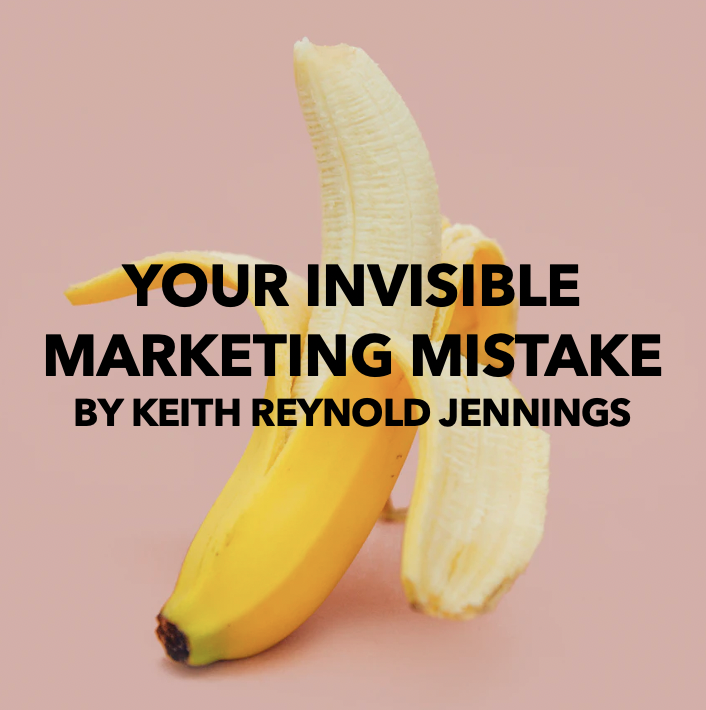
By Keith Reynold Jennings, {grow} Contributing Columnist
Years ago, I started noticing something people were doing with bananas.
Once I saw it, I couldn’t un-see it. It was something I realized I was doing too.
Bananas became a personal metaphor for everything that was wrong with marketing. And each time I see a banana, it serves as a reminder of the invisible marketing mistake we continually make.
In this article, I want to invite you into my banana observation and the hidden secret it reveals.
To get us started, I’d like you to participate in a quick visualization exercise with me.
My Banana Revelation
Picture yourself entering your kitchen. On the countertop are apples and bananas nestled in a serving bowl handcrafted from black walnut.
Walk over and pick a banana out of the bowl. Hold it in your hand for a second or two.
Now, peel the banana and imagine taking a bite.
Question #1:
“Which end of the banana did you peel open — the stem or the tip?”
I’m going to bet you opened your banana at the stem. Nearly everyone does. I do! Well, I used to.
Did you know that bananas are easiest to peel from the tip, not the stem? It’s true. If you pinch the tip, the peel essentially falls open revealing a perfectly intact banana. No twisting and tugging the stem. No gooey, disgusting banana.
Once I started noticing that most people peeled bananas at the same end — the wrong end — I had to ask, “Why?”
Question #2:
“If bananas are made to be opened from the tip, why do the overwhelming majority of people still open bananas from the stem?”
I think the simple answer is that, as kids, we’re either taught to do things a certain way or we copy what we see others do. And most of what others do originate in times long passed. Which leads us to…
Question #3:
“How much of what we’re doing today, as marketers, is the equivalent of peeling bananas at the wrong end?”
Can you see why I live with a banana complex?!
What’s most interesting to me is that we live in a world in which this banana hack is accessible to anyone. Yet every time I do the banana exercise with a group, it’s the first time the majority in the room learn about it.
And this is where we have to implement an important cognitive and behavioral change, as marketers and leaders.
If we were to first focus on the banana, rather than ourselves, we have a good chance of understanding how it is designed. Then, with a few peeling experiments, it wouldn’t take us long to figure out that bananas consistently peel easiest at the tip.
The problem, of course, is that operating in this way is mentally exhausting, which is why we don’t do it. Here’s why.
The marketing mistake
In his brilliant book, Thinking, Fast and Slow, Daniel Kahneman goes into great depth about the difference between what he calls, “System 1” and “System 2” thinking.
System 1 thinking is intuitive and instinctual. It’s fast, unconscious, and associative. System 2 thinking is rational. It’s slow, logical, and takes effort.
We operate on System 1 thinking 95% of the time. System 2 only kicks in when needed.
Let me give you two examples so you can experience these systems at work.
Solve this math problem: 1 + 1 = ?
That’s your System 1 brain at work. You didn’t have to pull out a calculator to work out the math. You instantly knew the answer, because it is stored in memory for fast retrieval.
Okay, next problem: 6 x 4,893 = ?
As you read that problem, your System 1 brain quickly said, “This one’s not me! This one’s for you, System 2. And your System 2 brain woke up and started looking for a calculator or paper and pencil.
System 1 thinking works with what Kahneman calls “cognitive ease.” System 2 thinking creates “cognitive strain.” It’s why in a stressful period or after an all-day planning session, we are mentally exhausted. And it’s why we unconsciously avoid as much cognitive strain as possible to preserve ourselves.
So let’s think back to your banana. Are you using System 1 or System 2 thinking when peeling a banana? You and I peel bananas with our fast, unconscious System 1 brain.
The root cause of this invisible marketing mistake is that most of our bad habits, most of our faulty or outdated learnings, are encoded in our System 1 brain.
We do much of what we do without being aware of it. Which means as you and your team are executing marketing each day, you are using System 1 thinking 95 percent of the time. In other words, we are phoning it in, despite what we tell ourselves!
It’s only when we encounter a real challenge that our System 2 thinking is activated and engaged. And it only remains active for the duration of its job. Then we immediately default back to System 1.
System 1 thinking is the reason marketers treat their customers and prospects as objects. It’s why we unconsciously put our business first, rather than our customers. And it’s why marketing has the negative reputation it has in the general public.
Are your customers subjects or objects?
Our System 1 brain treats everything as an object. Our System 2 brain can make anything a subject. Objects are boring. Subjects are infinitely interesting.
Think about it, an object is a tool we use to serve ourselves. On the other hand, a subject is something we serve. Subjects are infinitely knowable. It’s why after 50 years together, a couple continues to surprise and delight each other. It’s why someone can dedicate their life to studying a group of people, a place, an idea or thing and never tire of it.
This comes with a cost though. Treating your customers as subjects, rather than objects, is exhausting.
When I think of System 1 marketing, I think of Sergio Zyman’s definition:
“The goal of marketing is to sell more stuff, to more people, more often, for more money, more efficiently.”
When I think of System 2 marketing, I think of Peter Drucker’s definition:
“The purpose of marketing is to know and understand the customer so well, the product fits her/him, and sells itself.”
To achieve Zyman’s definition, you must start with Drucker’s definition. Knowing and understanding our customers, like taking time to know and understand a banana’s design, creates cognitive strain.
Learning to peel your marketing bananas
What can you and your team do today to begin serving your customers as subjects, rather than objects?
How can you overcome the busy-ness of the every day and push through the strain and fatigue System 2 thinking demands from you?
Here’s an idea to get your System 2 brain working. This is not intended to be a formula you follow, because your market, business size/stage, and culture is likely very different than mine.
Simply treat this as an approach to how you can organize and implement deep change without burning yourself and your team out.
Month 1: Market Audit
- How well do you really know your customers? What’s keeping them up at night right now? What functional, emotional, and social jobs are they trying to get done in their lives?
- What questions are you asking customers? Why? What questions aren’t you asking? Why not?
- What data are you collecting? Why?
- How are you structuring and using this data?
- Is your team engaging data because they’re supposed to or because they’re genuinely interested in it?
- How often are you having real conversations with your customers? Your competitors’ customers? Non-customers?
- How often are you in the field shadowing customers? How often should you be?
- How are you using social listening?
Month 2: Brand Audit
- What values does your business stand for?
- When is the last time you earned or lost a customer because of these values?
- What can you promise and guarantee that would scare your competitors and win new customers?
- Why aren’t you the #1 or #2 brand in your market? What will it take to get there?
- If someone asked 10 customers about your brand, what would they hear?
Month 3: Leads Audit
- Are your paid, owned, and earned media doing the jobs you’re hiring them to do?
- Is the next email campaign scheduled to go out designed to serve your business or your customer’s business? Prove it.
- What 20 percent of your spending is generating 80 percent of your leads?
- Who are the 10 influencers in your industry everyone listens to? Do they know, trust, and like you and your business? Why or why not?
Month 4: Conversion Audit
- How many clusters of prospects are moving in and out of your funnel?
- What makes each customer cluster distinct?
- Which specific clusters are converting? Why?
- Where, exactly, does marketing end and sales begin?
- Where are the most common breakdowns in your marketing and sales funnel? Why is each breakdown happening?
- How much does it cost to create a new customer?
Month 5: Retention Audit
- What, specifically, is causing existing customers to stick around? Is it price? Quality? Service? Brand? Laziness?
- How much does it cost you to keep a customer?
- Are your customers consumers or co-creators? Why?
There are hundreds of questions, like these, we could ask. And there are dozens of approaches we could take. Such as dedicating a week at a time to a specific area such as SEO, social channels, email optimization, etc.
The big idea is to:
- Stop surrendering your marketing to System 1 thinking
- Break down the deep thinking (i.e. System 2) you and your team need to do into bite-size phases
From Bananas to Ham (A Cautionary Tale)
The president of the company I work for tells a terrific story about holiday ham.
According to his mother, you prepare a ham by cutting off its ends, seasoning it, then roasting it in the oven. Curious about why you cut off the ends, he asked his mom.
“I’m not sure, that’s just the way my mom did it,” she replied.
So he called his grandmother and asked, “Why do you cut the ends off a ham before cooking it?”
“Oh, I have to do that because it’s the only way it fits in my little oven.”
The moral of the story: Question everything! We must seek to understand where the things we do as marketers came from. Then we must determine if it’s still relevant (or was ever relevant).
It’s time we overcome the invisible marketing mistake of blindly peeling our bananas at the stem. Instead, let’s find the most effective ways to peel those bananas.
I believe this starts with seeing our customers as infinitely discoverable subjects that we have the privilege to serve, rather than objects we use to serve ourselves.
 Keith Reynold Jennings is an executive and writer who serves as vice president of community impact for Jackson Healthcare. He’s also an advisor to goBeyondProfit. Go deeper with Keith on Linkedin or Medium.
Keith Reynold Jennings is an executive and writer who serves as vice president of community impact for Jackson Healthcare. He’s also an advisor to goBeyondProfit. Go deeper with Keith on Linkedin or Medium.


